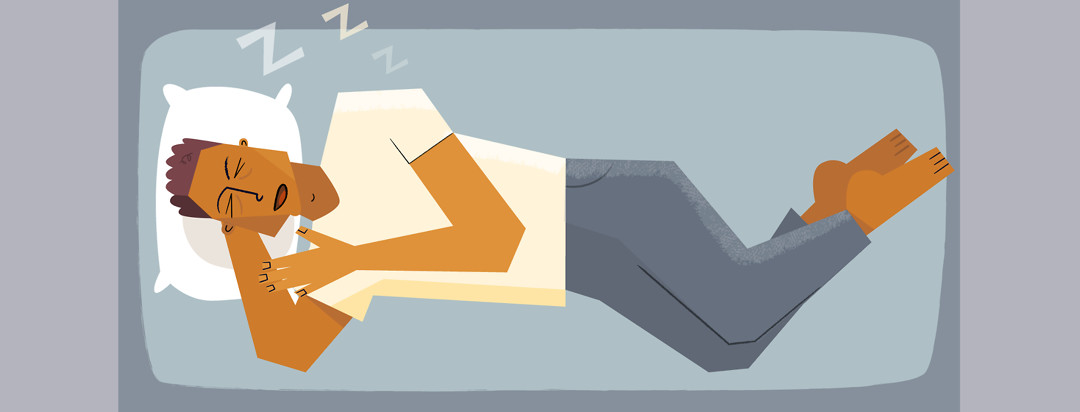Sleep Apnea and Diabetes
Recent research confirms not only a relationship between type 2 diabetes and sleep-breathing disorders but that the relationship is bidirectional. This means poorly managed type 2 diabetes can lead to the development of sleep apnea and vice versa.1
Let’s examine how these two chronic illnesses influence each other.
Sleep apnea: the basics
Sleep apnea affects as many as 18 million Americans.2 It’s considered a sleep breathing disorder, in which one’s breathing, while asleep, is interrupted by periods (apneas) when breathing is partially or completely paused for at least 10 seconds.
After apneas occur, the body responds with floods of stress hormones in response to changes in blood chemistry. Arousals from deeper sleep stages to lighter ones, or complete awakenings, occur as the brain stimulates the respiratory system to resume breathing.
People with sleep breathing disorders are generally sleepy during the day, use the restroom frequently at night, may struggle with sleeplessness, and have symptoms like high blood pressure, headaches, and insulin resistance.
The three kinds of sleep apnea
Obstructive sleep apnea (OSA)
OSA is defined as pauses in breathing which are caused by obstructions in the upper airway. This can occur due to oversized tissues (tonsils, tongue, uvula), additional fatty tissue in the neck area, or as the result of specific kinds of cranial and jaw formations which mechanically interfere with breathing while one sleeps.
People experiencing OSA will often snort or gasp after long stretches when they don’t breathe, though their chest and diaphragm may rise in an effort to breathe. Alcohol or muscle relaxants at bedtime may also lead to OSA.
Central sleep apnea (CA)
CA is defined as pauses in breathing which are caused by mixed neurological signals between the brain and the respiratory system. People experiencing CA appear to not be breathing at all, or breathe in a unique waxing-waning pattern that causes deep dives in blood oxygen and rises in carbon dioxide.
Mixed sleep apnea (MA)
MA is simply a combination of both kinds of sleep apnea.
Important: One can have healthy weight and still have sleep apnea. Sleep apnea also occurs in both males and females, and it can happen at any age.
What about snoring and sleep apnea?
Snoring describes the friction produced by the upper airway tissues during sleep when someone is breathing. This friction creates the characteristic “sawing” noise, which can be very light or extremely loud.
Generally speaking, one does not necessarily have sleep apnea if they snore; however, most people with sleep apnea also snore loudly over long periods during the night.
Upper airway resistance syndrome (UARS) is a similar condition of sleep-disordered breathing in which the person experiencing airway obstructions may not experience the blood chemistry changes or breathing behaviors linked to sleep apnea. However, they will awaken frequently at night and experience the same stress hormone surges, as well as daytime sleepiness, hypertension, and other symptoms.
Links between sleep apnea and type 2 diabetes
Imbalanced blood chemistry is the common denominator for both sleep apnea and type 2 diabetes.
Sleep apnea causes increases in carbon dioxide and decreases in oxygen in the bloodstream. When this imbalance occurs, insulin resistance develops, causing more glucose to enter the bloodstream. Occurring nightly, sleep apnea creates the proper conditions for developing diabetes.3
Type 2 diabetes is the result of elevated and uncontrolled blood glucose levels. Even if people are disciplined in treating their type 2 diabetes, it will still be a struggle if they also have untreated sleep apnea. As much as 80 percent of people with type 2 diabetes will have OSA, according to the American Thoracic Society.4
Obesity is a third part of the relationship between type 2 diabetes and sleep apnea. People with diabetes often have problems managing weight. While sleep apnea happens to people of all sizes, those with sleep apnea who are also obese have a much higher risk for developing type 2 diabetes. People who are obese and have sleep apnea, but don’t have diabetes initially, are destined to develop it.
Research published in 2018 shows that those with sleep apnea are more likely than those without sleep apnea to develop type 2 diabetes. Yes, even snoring is associated with developing diabetes.5
Finally, diabetes can alter the activity in the autonomic nervous system, which regulates breathing and hormone release, showing the possibility that sleep apnea can be an outcome to unmanaged diabetes. 6
Do you suspect you have sleep apnea?
If a loved one has witnessed you gasping in your sleep or long pauses in your breathing during sleep, or if they complain about snoring, it’s time to talk to your doctor. If you also carry extra weight, know that this factor alone suggests you are at higher risk for having sleep apnea.
It’s critical that people with diabetes identify and treat an underlying case of sleep apnea, as untreated sleep apnea will complicate diabetes management.3

Join the conversation